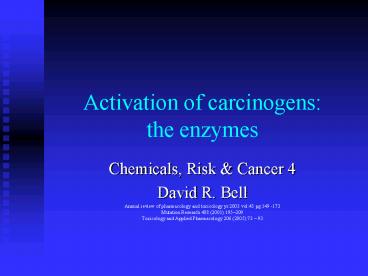Activation of carcinogens: the enzymes - PowerPoint PPT Presentation
1 / 23
Title:
Activation of carcinogens: the enzymes
Description:
Annual review of pharmacology and toxicology yr:2003 vol:43 pg:149 -173. Mutation Research 488 (2001) 195 209. Toxicology and Applied Pharmacology 206 (2005) 73 93 ... – PowerPoint PPT presentation
Number of Views:63
Avg rating:3.0/5.0
Title: Activation of carcinogens: the enzymes
1
Activation of carcinogensthe enzymes
- Chemicals, Risk Cancer 4
- David R. Bell
- Annual review of pharmacology and toxicology
yr2003 vol43 pg149 -173 Mutation Research 488
(2001) 195209 Toxicology and Applied
Pharmacology 206 (2005) 73 93
2
Activation
- Activation is split into two phases
- Phase I
- Direct oxidation/ metabolism of the primary
compound - Phase II
- Conjugation of the compound/ metabolite with a
hydrophilic compound (glutathione, SO4, sugar)
3
Why activate ?
- Why activate compounds ?
- Hydrophobic compounds are bad
- Accumulation of hydrophobic compounds in cell
membranes/ fatty compartments - Accumulation means very high concentrations in
specific organs - Highly toxic compounds are often highly
hydrophobic
4
Fatty compounds accumulate
Fat
Blood
In
Brain
Out
Kidney
Other tissue
5
Why metabolism ?
- Metabolism of foreign compounds makes them more
hydrophilic, ie water-soluble - Water-soluble compounds are in the bloodstream,
and are passed by the kidneys - Phase I- add oxygen, or hydroxy groups
- Phase II- add hydrophilic molecules to functional
groups, e.g. OH, -NH2 created in phase I
6
Metabolism
- Gut metabolism
- The gut contains a great number of bacteria
- Bacterial metabolism of foreign compounds is
significant - Frequently anaerobic, ie reducing
- Vs. hepatic metabolism, frequently oxidising
7
Phase I
- Cytochrome P450
- Unique spectral characteristic
- Compare reduced enzyme, vs reduced enzyme CO
gives a peak at 450 nm - Pigment 450nm
- Has protoporphyrin IX (haem) prosthetic group
- Principally hepatic, but present in many other
organs
8
Fe3 prosthetic group
H2O
R
N
N
Fe 3
N
N
S
H
9
P450 cofactors
- P450 present in the endoplasmic reticulum
- Requires
- NADPH-cytochrome P450 reductase
- (Optional) cytochrome b5
- O2
- NADPH
10
P450 reaction cycle
Substrate R-H
P450 3
ROH
H2O
P450 3 -RH
NADPH P450 reductase
2 H
e-
O22-- P450 3 -RH
P450 2 -RH
P450 reductase or b5
e-
O2
O2- P450 2 -RH
O2-- P450 3 -RH
11
P450 reactions
- C, N or S- hydroxylation, or oxidation
- dealkylation
- reduction
- dehalogenation
- wide variety of substrates
- multiple P450s
- each of which has wide substrate specificity
12
P450 structure
13
P450 gene family
- gt 1200 genes known
- Humans have 17 families, 42 subfamilies
- Present from plants, bacteria to human
- Conserved structural features
- P450s are grouped into
- Families e.g. CYP1, or CYP2
- Subfamilies, e.g. CYP1A and CYP1B
- Individual genes, e.g. CYP1A1 and CYP1A2
14
P450 and cancer
- P450 4B1 (mouse, rabbit) responsible for tissue
specific activation of aromatic amines (2AAF) in
bladder, rabbit lung - CYP1A1 and CYP1A2 responsible for metabolic
activation of PAHs - Furafylline specifically inhibits 1A2
- CYP2D6 is highly polymorphic in humans
- 95 normal metabolisers of debrisoquine
- 5 very poor metabolisers
- Relevance to cancer ?
15
P450s as an adaptive response
- When yeast are grown on lipids, they induce high
levels of fatty acid hydroxylases - Induction of cytochrome P450 is an adaptive
response to environmental chemicals - The induction of cytochromes P450 1A1 in the skin
appears to be essential for PAH carcinogenesis - Specific inducing agents lead to the induction of
distinct P450 forms
16
Phase II
- Addition of a hydrophilic carrier moiety to make
the compound more water soluble - Rapid excretion
- Tissue-specific availability of Phase II enzymes
determines further metabolism of compounds
17
Sulphation
- Formation of ATP analogue, phospho-adenosine-phosp
ho-sulphate - The enzyme family, the sulfotransferases,
transfer the sulphate to the substrate - PAPS ROH 3phosphoadenosine 5 phosphate
ROSO3H - Widely used for the metabolism of endogenous
substrates (steroids, neurotransmitters) and
foreign compounds
18
Acetlyation
- Addition of acetic acid in a condensation
reaction - R-OH CH3COOH? RO-CO-CH3 H2O
- N-acetyl transferase family is polymorphic in
humans - Final compound may be less hydrophilic than the
starting compound
19
Glucuronidation
- The addition of glucuronic acid, as
UDP-glucuronic acid, catalysed by a family of
enzymes known as UDP glucuronyl transferases - Endogenous and exogenous substrates
- Deficiency in human UGT1.1 leads to a failure to
excrete bilirubin, and Crigler-Najjar disease,
characterised by a potentially fatal neurological
syndrome (kernicterus)
20
UDPGTs
COOH
COOH
UDPGT
O
O
O
OH
O-UDP
UDP
21
Glutathione
- Glutathione is a tripeptide
- g-glutamyl-cys-gly
- Present in most cell types, at 1-10 mM
- Available to mop up reactive species
NH2
O
H
NH
COO-
N
-OOC
CH2
O
SH
22
Glutathione S-transferase
- R-OH GSH ? R-SG H2O
- Catalysed by a family of enzymes, GSTs
- Deletion of murine GST-p cluster
- Treat mice with DMBA, wait 20 weeks
- / mice 2 papillomas/ animal
- -/- mice 9 papillomas/ animal
- GST-m is polymorphic in human
23
Enzymes of metabolic activation
- Tissue-specific expression
- Species specific
- Developmental
- Sex
- Diet
- The balance between activating and detoxifying
pathways of metabolism is determined by a complex
interplay of metabolic pathways































